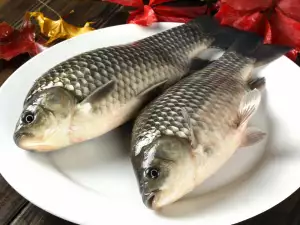Sturgeon is the common name for several species of fish belonging to the Acipenseridae family. The sturgeon is a bony fish but unique amongst them in that the majority of their skeleton is cartilaginous. Another characteristic trait of these marine inhabitants is that they have 5 rows of bone plates along their body length. Most members of the family have an elongated, pointed nose and barbels.
Additionally, the upper torso is colored dark blue to black. The belly is silver or nearly white. Most species of
sturgeon migrate, moving from salt to freshwater. They go into rivers mainly to release their roe, after which they return to the sea.
History of Sturgeon
Sturgeon is a fish of ancient origins. Its ancestors are thought to have lived during the Jurassic period. In the relatively not-so-distant past, sturgeon was found in the rivers and seas of the planet's northern hemisphere. In fact it was so common in Germany that they had even founded a special sturgeon market there. But due to increased fishing of sturgeon in Europe and America, the population has dropped significantly over the years.
At the onset of the last century, sturgeons inhabiting the Black, Caspian and Azov Seas were of the highest aquacultural significance. Besides for meat, sturgeons are of importance in obtaining black caviar. This delicacy became highly prized by the Russians an entire century ago.
Species of of Sturgeon
The Acipenseridae family encompasses numerous species, the most popular among them being the Beluga sturgeon, Russian sturgeon, Siberian sturgeon, starry sturgeon and sterlet.
The Beluga sturgeon is considered the largest representative of Acipenseridae fish. It can live up to 100 years, growing up to several meters and weighing up to 2646 lb (1200 kg). In this species of fish sexual maturity occurs later, with mating taking place every few years. The roe is released in rivers where newly born Beluga sturgeons then feed on invertebrates.
The Russian sturgeon is characterized by much more modest sizes. It can weigh up to 44 lb (20 kg) and reach lengths of about 6.5 ft (2 m). Its lifespan is about 50 years. Sexual maturity in females occurs when they reach 12 years of age and 6 years in males. Mating takes place every 3 to 4 years. Small specimens feed on organisms in the upper aquatic layers.
The Siberian sturgeon is about 6.5 ft (2 m) long and weighs about 440 lb (200 kg). This species lives up to about 60 years. Female specimens reach sexual maturity in their 17th year. In males, sexual maturity happens once they reach 11 years of age. This species is considered able to easily adapt to changing conditions and can be kept in specialized aqua farms and artificial water basins.

The starry sturgeon reaches 6.5 ft (2 m) in length and grows up to 176.5 lb (80 kg). Its lifespan is approximately 25 years. In males sexual maturity happens in their 4th year, and in females - during their 8th year. Mating takes place every 2 to 3 years.
The sterlet reaches 3.3 ft (1 m) in length max. The maximum weight of the fish comes out to 44 lb (20 kg). The sterlet is known as the smallest species of sturgeon. Sexual maturity in males occurs after they reach 4 years of age, while in females it's when they reach at least 7. It swims freely in nature but is also kept in aqua farms.
Cooking Sturgeon
Sturgeon meat is favored by chefs since it isn't filled with tiny and annoying bones, capable of ruining the charm of any specialty. As far as taste, the fish is extremely appetizing. You would be hard-pressed not to notice that its meat is similar to land animal meat. This is owed to the contained therein glutamic acid.
The fish can be heat treated in various ways without a problem - baked in the oven or on the grill or fried in a pan. Sturgeon is also suitable for sauteing, marinating and crumbing.
With a little help from spices such as tarragon, basil, celery, black pepper, white pepper, cloves, thyme, melissa, dill and parsley it transforms into the perfect component for soups, stews, casseroles, clay pot dishes, salads, sandwiches, pizzas, spaghetti.
It goes well with all kinds of vegetables, including mushrooms and rice. If you're still stuck unable to decide what to prepare with your sturgeon, you can try out baked sturgeon with salsa and sauteed sturgeon.
Benefits of Sturgeon
Eating sturgeon meat is healthy for many reasons. First off, it's a source of vitamin A, vitamin D and vitamin E. All of these vitamins are of high importance for the proper development of the body and maintaining good health. Besides vitamins and minerals, it contains essential amino acids and essential fatty acids.
Sturgeon meat is a source of glutamic acid, a decent source of polyunsaturated, sulfur-containing eicosapentaenoic and docosahexaenoic acids, making it an exceptional food product. Eating sturgeon also has a beneficial effect on the brain, eyes and heart.
Further, it's been proven to have a positive effect on the skin, hair and nails. According to experts, this type of fish is an excellent prophylactic against atherosclerosis. Besides sturgeon's meat, its caviar is also healthy. It is a source of polyunsaturated fatty acids and is recommended for weak and frail persons, as well as for patients with high blood pressure.















Comments